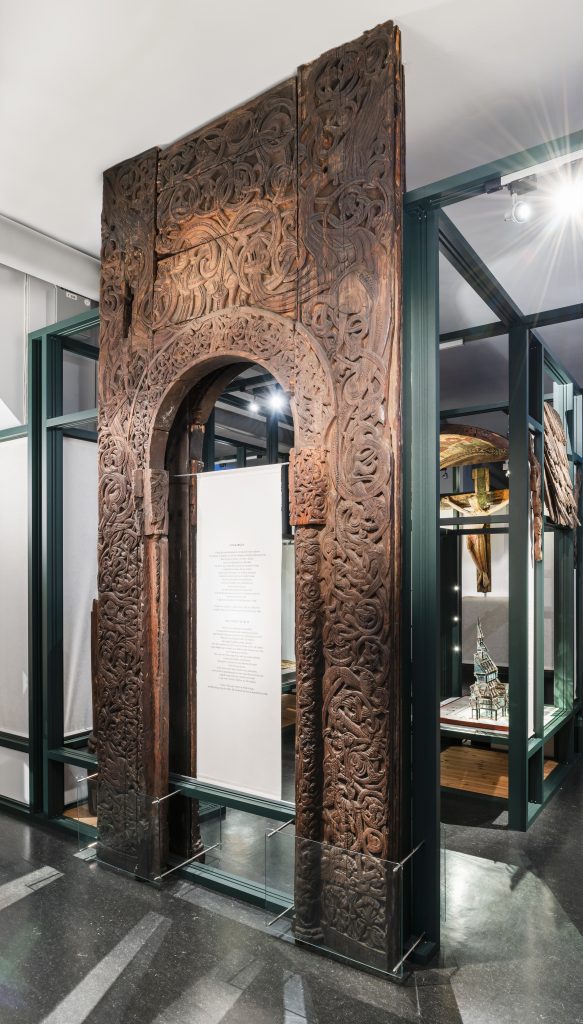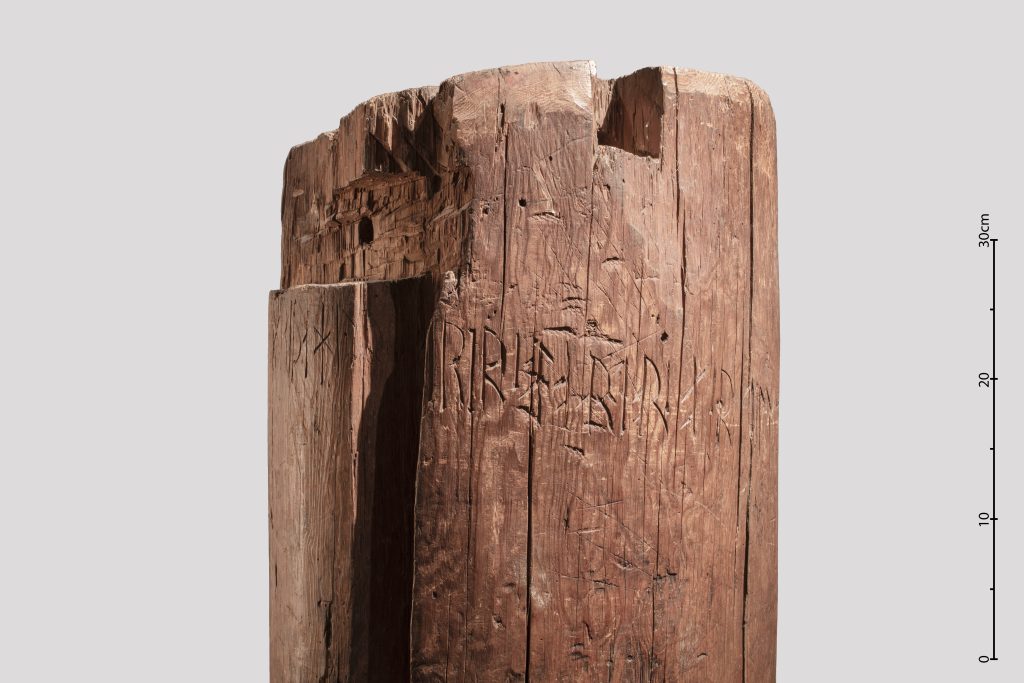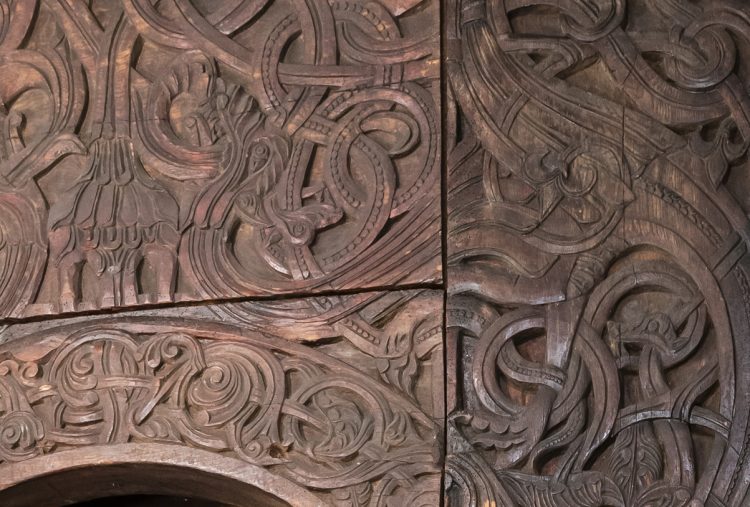Both portals, which can be dated to around 1180, stem from the stave church at Stedje at the Sognefjord, which was demolished in 1867. Their carved decorations place them in the so-called Sogn-Valdres II type, which was widespread in this region.


The undecorated base of the first portal (Stedje I) is topped by a palmette frieze, above which animal heads appear en profil on either side of the door opening, directly next to the half-columns. From the mouths of the animals grows the main tree that meanders over the entire surface of the portal. From it springs a complex pattern of intertwined vines that branch off in inward and outward spirals. The vines all end in three-petalled leaves. Between the spirals are dragons that seem to be biting the vines. At the level of the richly decorated arch, which is supported by cylindrical capitals, rise two dragons whose tails are integrated in the decorations of the door jambs. Their long necks rest on the arch, and with their opened mouths they bite a garland covering a centrally placed animal that has its claws planted in the top of the archivolt. The wings of the dragons reach to the upper rim of the cornice. The vegetal ornamentation also covers the surfaces of the half-columns, capitals, and crowning arch.
A second portal from the same church, known as Stedje II, shows close parallels with Stedje I. Above the undecorated base sits a palmette frieze under animal heads rendered en profil. The decorations continue in the shape of a spiralling pattern up to the capitals. Above the arch, as in Stedje (I), two dragons face each other. Among all preserved stave church portals in Norway, the examples from Stedje stand out for their large size.
The original location of the portals is unknown. While Stedje II has a wider door opening and might therefore be identified as the church’s main westportal, the portal Stedje I shows a slightly richer decorative pattern, which could indicate its function as a priests’ entrance. This uncertainly is the result of the fact that the chancel of the relatively large stave church was replaced before 1722 and a west tower and spire added, as shown on a drawing by Hermann Schirmer from 1862. Until the church was demolished in 1867, the medieval nave and part of the surrounding arched corridor (in Norwegian: ‘svalgang’) were still standing.

In general terms, the decorated carved portals from Norwegian stave churches share several common characteristics with stone architecture of the twelfth century in Western and Central Europe (for example, Ely in England, Mainz in Germany, and Pavia in Italy). But while the structure and ornamentation of Norwegian stave church portals was largely based on European models, their decorative patterns merged with earlier Nordic traditions.
From the church in Stedje, the Bergen Church Art Collection also holds the lower part of a stave. At a height of around 80 cm, an inscription in Old Norse runes was carved into its surface, reading: ‘Þenna staf gaf Sigríðr á Hv[áli f]yrir sálu Arndórs ok sér til miskunnar’ (‘This stave gave Sigrid of Kvåle for the soul of Arndor and for her Salvation’). The Sverres saga mentions a certain Arnþórr, who lived on Kvåle Manor not far from the church at Stedje. According to the saga, he was the leader of the inhabitants of Sogndal in their uprising against the governor (in Norwegian: ‘sysselmann’) of King Sverre Sigurdsson during the Norwegian Civil War in the winter of 1183-1184. This uprising led to the battle of Fimreite on the Sognefjord in June 1184, in the course of which all the farms in the area were plundered and only the church was spared. Lorentz Dietrichson assumed that the Arnþórr mentioned in the text is the same as the one in the inscription. He may have died before the battle, as the saga text does not mention him in this context. This would lead to the conclusion that the church was finished before June 1184.


Runologists Magnus Olsen and Oluf Rygh raised doubts over this thesis, suggesting that the saga records a different clan member with the same name. Moreover, they assume an earlier date for the church, arguing that the saga would certainly have mentioned a recently finished church building. On stylistic grounds, however, the Runic inscriptions cannot be dated earlier than 1160-1175. In either case, the inscription offers a rare insight into the devotional practice of the Middle Ages, in which parishioners shared in the building of a stave church. Similar communal activity is found in the Auvergne (France), where several twelfth-century churches have capitals depicting lay persons presenting columns. In Volvic, for example, a priest is shown receiving a column from the hands of a layman, identified in the inscription as Guillelme de Bezac, who makes the gift ‘for [the salvation of] his soul and that of his wife’.
Norway, c. 1180
From Stedje (Sogn), in the museum since 1867
Pinewood
H 424 x W 204 x D 17 cm (portal I)
H 425 x W 186 x D 15.5 cm (portal II)
H 157 cm, diameter 54 cm (stave)
Inv. no. MA 122 a-c (portal), MA 123a-c (portal), MA 125 (stave)
